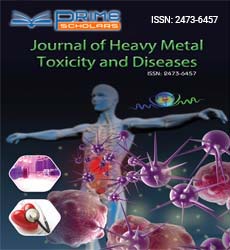Perspective - (2023) Volume 8, Issue 6
Navigating the Shadows: Unraveling the Health Effects of Heavy Metal Exposure
Well Miller*
Department of Environmental Research, Duisburg University, Germany
*Correspondence:
Well Miller,
Department of Environmental Research, Duisburg University,
Germany,
Email:
Received: 29-Nov-2023, Manuscript No. ipjhmct-24-18973;
Editor assigned: 01-Dec-2023, Pre QC No. ipjhmct-24-18973 (PQ);
Reviewed: 15-Dec-2023, QC No. ipjhmct-24-18973;
Revised: 20-Dec-2023, Manuscript No. ipjhmct-24-18973 (R);
Published:
27-Dec-2023, DOI: 10.21767/2473-6457.23.6.54
Introduction
Heavy metal exposure is a pervasive environmental concern, with
potential consequences that extend beyond the visible realms of
polluted waters and contaminated soils. The intricate interplay
between heavy metals and human health underscores the urgent
need to understand the acute and chronic effects of exposure.
This article delves into the shadows, exploring the multifaceted
health impacts associated with heavy metal exposure.
Description
Lead, a ubiquitous heavy metal, is notorious for its acute toxicity.
Ingestion of lead-contaminated water, food, or dust can lead
to symptoms such as abdominal pain, nausea, and vomiting.
In severe cases, lead poisoning may result in seizures, coma,
and even death. Children are particularly vulnerable, and lead
exposure during early development can cause developmental
delays and cognitive impairments. Acute mercury exposure,
often associated with the consumption of contaminated fish, can
lead to symptoms like muscle tremors, difficulty breathing, and
nausea. Methylmercury, a particularly toxic form of mercury, can
cross the blood-brain barrier and cause neurological damage.
Minamata disease, a tragic incident in Japan in the mid-20th
century, exemplifies the devastating consequences of acute
mercury poisoning. Acute cadmium exposure primarily occurs
in industrial settings or through ingestion of contaminated
foods. Symptoms may include abdominal cramps, vomiting,
and diarrhea. Severe exposure can lead to respiratory distress
and organ failure. Itai-itai disease in Japan serves as a historical
example, where chronic cadmium exposure led to severe bone
and kidney damage. Arsenic, a naturally occurring element, can
cause acute poisoning when ingested in high amounts. Symptoms
may include abdominal pain, vomiting, and diarrhea. In extreme
cases, arsenic poisoning can result in cardiovascular collapse and
death. Chronic exposure to lower levels of arsenic is associated
with an increased risk of skin, lung, and bladder cancers. Chronic
exposure to certain heavy metals, such as lead and mercury,
can result in long-term neurological impairments. In children,
lead exposure is linked to developmental delays, learning
disabilities, and reduced IQ. Mercury exposure, especially during
fetal development, may lead to cognitive deficits, attention
disorders, and motor skill impairments. Cadmium is notorious
for its impact on the kidneys. Chronic exposure can lead to renal
dysfunction, including proteinuria and glomerular damage.
The long-term consequences may culminate in chronic kidney
disease, necessitating dialysis or transplantation. Occupational
exposure in industries like battery manufacturing is a common
source of chronic cadmium exposure. Some heavy metals,
including lead and cadmium, have been associated with
cardiovascular complications. Chronic lead exposure is linked to
hypertension and an increased risk of heart disease. Cadmium
exposure is correlated with atherosclerosis and an elevated risk
of cardiovascular events, including heart attacks and strokes.
Chronic exposure to certain heavy metals, notably arsenic and
cadmium, is associated with an increased risk of cancer. Arsenic
exposure, often through contaminated drinking water, is a known
carcinogen linked to skin, lung, and bladder cancers.
Conclusion
The intricate dance between heavy metals and human health
paints a sobering picture of the potential consequences of
exposure. The acute effects, though stark and immediate,
often pale in comparison to the insidious, chronic impacts that
unfold over time. As we navigate the shadows of heavy metal
exposure, it becomes imperative to address not only the sources
of contamination but also to implement stringent regulatory
measures, adopt safer industrial practices, and educate
communities about the risks. By understanding the complex
interplay between heavy metals and health, we can work
towards a future where the shadows are lifted, and the wellbeing
of individuals and communities is safeguarded against the
silent menace of heavy metal exposure.
Citation: Miller W (2023) Navigating the Shadows: Unraveling the Health Effects of Heavy Metal Exposure. J Heavy Met Toxicity Dis. 08:54.
Copyright: © 2023 Miller W. This is an open-access article distributed under the terms of the Creative Commons Attribution License, which permits unrestricted use, distribution, and reproduction in any medium, provided the original author and source are credited.

